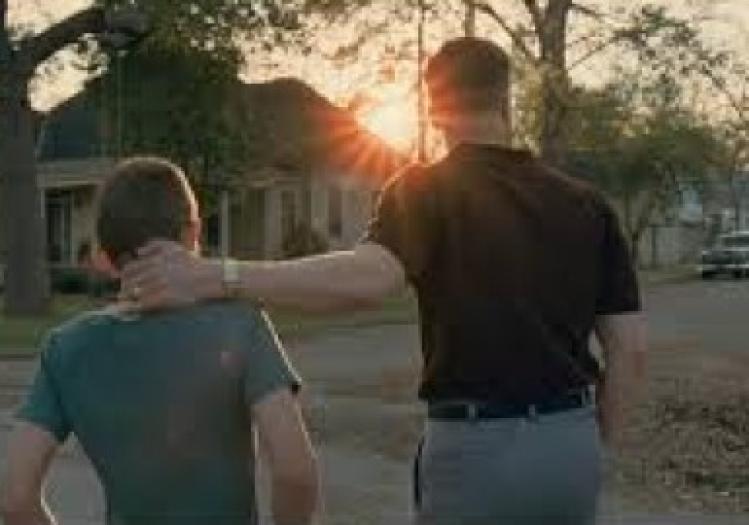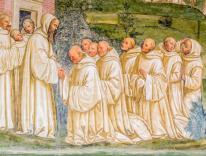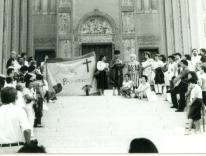
The Tree of Life may or may not be a cinematic masterpiece, but it is certainly one of the most impressive attempts to use cinema to do theology. Many critics were swayed by the film’s impressionistic style, its ravishing musical score, its exquisite cinematography and elaborate special effects; The Tree of Life won the Palme d’Or at Cannes and was nominated for Academy Awards in the categories of Best Picture, Director, and Cinematography. But many ordinary viewers—and some critics—consider the film’s impressionistic and nonlinear style a symptom of narrative incoherence. They left the movie with a sense of having been exposed to something important, without being sure of what that might be.
The film’s story is at once universal and highly particular. The middle-aged protagonist, Jack O’Brien (Sean Penn), is a successful architect, the oldest of three brothers who grew up possibly Catholic (the movie does not make their religion clear) in 1950s Waco, Texas. Jack looks back at the joyous and poignant memories of his early life, memories triggered by the commemoration of his younger brother’s death at the age of nineteen. Terrence Malick’s own life seems to have supplied much of the scaffolding for the film; the director grew up in Texas and had a brother who died at nineteen.
The lives of the three brothers are evoked with stunning attention to the details of childhood experiences and perceptions, above all those concerning their parents. Their father (Brad Pitt) is a gifted musician who works for a corporation while seeking in vain to make a fortune through developing patents. He loses his job, and the family must move from the place where, with his first son, he had planted a “tree of life” in the yard—a tree that became a point of reference for many of the boys’ activities. O’Brien is a complicated man, driven partly by rigid idealism and partly by envy of those who are better off in life. Righteous, but unaffectionate and formidable, he demands of his son, “Do you love your father?”—forcing the son to answer, “Yes, sir.”
In contrast, the boys’ mother (Jessica Chastain) is a blithe and gentle spirit who seems to desire nothing more than the life she shares with her husband and children. Lovingly nurturing in her boys a sense of playfulness and wonder, she personifies the film’s definition of grace; even as she gives to others, so does she receive affliction. The boys feel pulled between the ways of life exemplified by their parents, which The Tree of Life explicitly identifies as “the way of grace,” which “does not please the self and accepts being slighted,” and “the way of nature,” which “only wants to please itself, and gets others to please it.” We must, Jack O’Brien’s voice-over tells us, “choose which one to follow.”
But while the two younger boys—above all the middle son, R. L.—are drawn unambiguously toward their mother’s way of grace, Jack is divided within: drawn to the simplicity and joy of his mother, he envies R. L. for being so much like her; at the same time he grasps that this envy, and the rage it engenders, make him more like his father. He desires his father’s death, yet declares to him, “I’m as bad as you are. I’m more like you than her.” The film traces Jack’s movement, through memory, toward an attitude of acceptance and forgiveness, such as he learned from his mother and brother, which extends also to his father.
The family dynamics are instantly recognizable. We may think of Cain and Abel when, alone in the woods, Jack coaxes R. L. to put his finger over the barrel of a BB gun and then fires it. We may think of Oedipus when Jack’s gaze lingers on his mother and glowers at his father (“Please kill him,” the voice-over whispers; “She only loves me.”) But if the dynamics are universal, the setting is acutely specific. One of the virtues of the film is how it so cannily captures the nature of those years, in that place, as experienced by boys like these: the feel of summer evenings spent throwing a ball or chasing the DDT truck as it sprays for mosquitoes; the fear and wonder at the sight of people who look and act differently; the tense moments at meals when the authoritarian father’s demands for proper behavior explode into physical violence (“Why does he hurt us, our father?”). And any boy who has survived adolescence will recognize the painful moments of awakened sexuality—the helpless obsessiveness—as well as the surges of deflected anger that find expression in cruelty to insects and toads, and, alas, younger siblings.
Despite its magnificent precision in capturing these discrete moments, the film also frustrates. Malick relies heavily on small snippets of dialogue, and above all on whispered voice-overs, some of which are simply hard to hear. The episodic and almost dreamlike character of The Tree of Life, its impressionistic style—with many bridging views of treetops, water, grassy fields, birds, butterflies—can seem incoherent. Why is the cause or manner of R. L.’s death never stated? Why should it elicit such remorse in O’Brien, who mentions “shaming” the young boy? How did the planting of a tiny tree become a mighty live oak in subsequent shots? If O’Brien’s loss of his job meant the loss of their house, how is the family living in an elegant setting when news arrives of his son’s death? Why does the middle-aged Jack light a votive candle for R. L.—as his father had done earlier in a church? Why does he have visions of trudging through a desert landscape? What is the meaning of the door in the middle of the wilderness that morphs into a door at the end of a pier? What exactly are we to make of the seaside beach on which the family—with countless others—seems to be wandering at the end of the film? Why does Jack appear in that final scene as his adult self while his parents and brothers appear as they were in his childhood? The sheer gorgeousness of the film allows us to forgive these and other loose ends, but they are bothersome nevertheless.
Perhaps these problems reflect not a lack of cinematic craft—the evidence of Malick’s skill on that score is abundant—but rather the daunting nature of trying to make a film about ordinary people that is suffused with cosmic significance. There is no mistaking Malick’s theological intentions, nor for that matter the academic credentials he possesses to make such an effort. A Phi Beta Kappa scholar who graduated from Harvard University in philosophy, Malick was a Rhodes Scholar at Oxford, worked on a thesis on Kierkegaard, translated Heidegger, and taught philosophy at MIT.
THE THEOLOGICAL DIMENSION of his film is by no means limited to the realm of the religious. True, the O’Brien family evinces the conventional piety of the 1950s: they go through the rituals of baptism and Eucharist; hear sermons and light votive candles; say grace at meals; attend funerals. But the true theological dimension enters through the means Malick employs to subvert the traditional Jewish and Christian choice between the “two ways.” The film opens with an epigraph drawn from the words of God in the Book of Job (38:4, 7): “Where were you when I laid the foundation of the earth, when the morning stars sang together, and all the sons of God shouted for joy?” And at both the beginning and the end of the film, we see a flame flickering in the darkness, signaling the eternal offstage presence of God behind the surface play of the human drama.
What happens in the lives of the O’Briens, Malick suggests, must be perceived not only as the interaction of human desire and revulsion, and surely not merely as a controllable calculus of reward and punishment, but rather as participation in the impenetrable mystery of God and God’s continuing creation of the world—a mystery that at once relativizes and enhances the drama of familial interaction. Malick asks us to see that while God is not visibly present among the O’Briens, God’s implicit power and presence is active among them, in ways both light and dark.
That Malick regards the Book of Job as the text through which the film’s events are to be perceived is made clear by the sermon, preached by a priest in mid-film, pointing out that misfortune befalls the good as well as the evil, and that no human effort can protect us from suffering. Another unmistakable allusion comes in a relative’s statement of comfort to Mrs. O’Brien following the death of her son: “The Lord gives, the Lord takes away; that’s the way he is. He sends flies to wounds that he should heal.” More subtly, Malick uses Jack’s voice-overs not only to express aspects of his remembered family history, but to articulate his relationship with God, in questions and statements that evoke those Job posed to God: “Who are we to you? Answer me.” “I want to be where you are. I want to see what you see.” “I didn’t know how to name it then, but I say it was you. Always you.” “God’s hand the whole time. I shall fear no evil for you are with me.” “Before I knew I loved you, I believed in you. When did you first touch my heart?”
Strikingly, Malick wants us to see that the relationship with God is not distinct from human interactions but in fact is mediated by them; speaking of childhood, Jack says, “That’s where God lives.” Above all, Jack’s path toward God is linked to the way of grace displayed by his mother and younger brother. “Brother. Mother. It was they who led me to your door,” Jack whispers in voice-over. And at the end: “The only way to be happy is to love. Unless you love, your life will flash by.”
In all of this, I find The Tree of Life, its irritatingly quiet voice-overs notwithstanding, an astonishingly rich exercise in theological reflection. The combination of everyday life and life crisis, read through bits of Sacred Scripture and interpreted through meditative recollection, strike me both as an exemplary theological method and as an innovative use of cinema in service to theology that goes far beyond any film I can recall.
Those who have seen the film may wonder at my omission of one of its most attention-grabbing sequences—the sixteen minutes of sight and sound that begin with the Big Bang and end with the birth of the infant Jack, and the vision of the “end-time” in which members of the family reunite on a sandy strand that we assume stands for the shore of eternity. I will leave aside the obvious imbalance between these two explicit pointers to transcendence: whereas the depiction of cosmology is powerful and clear, the eschatological vision is oddly weak and vague. More important for the question of theological method is whether such explicit glimpses of the divine process detract from, rather than enrich, the theological texture of the film. Certainly, viewers are provided help in perceiving the human drama as participating in a larger cosmic drama. But I think it is precisely such breaking of the narrative plane that shifts attention from the way in which Malick has so compellingly interwoven the empirical and the transcendent, and represents, in fact, a distraction from what is most genuinely theological in this movie.
The rich allusiveness of the film extends to its title. What does Malick want us to understand by “the tree of life”? It is not clear. The planting of a tree that becomes the center of childhood activity roots metaphorical meanings in something real that lives and grows as the boys themselves do. And the constant attention to trees and leaves and the things that live in and among them serves to remind the viewer of the tree motif. Given the film’s commitment to biblical intertextuality, we might think in terms of the tree of life planted in the garden of Eden; certainly Jack’s eating from the tree of the knowledge of good and evil—a way of reading his progression to adolescence—appears to lead to a banishment from the Eden and the tree of life that was the place of the boys’ childhood. Yet that Eden was already one in which both good and evil were at work. Alternatively, the tree of life might allude to the theme of the cosmic tree from which all flows and in which all things are united.
As with so many other aspects of this movie, these possibilities stimulate thought while providing no easy resolution. What greater praise might a theologian give to a film than to say that it also demands of its viewers serious and difficult thought about the meaning of life before God?
Funding for this essay has been provided by a grant from the Henry Luce Foundation.
Please email comments to [email protected] and join the conversation on our Facebook page.
Previous Story
'How All Things Fit Together'
Next Story
What Is He Up To?

